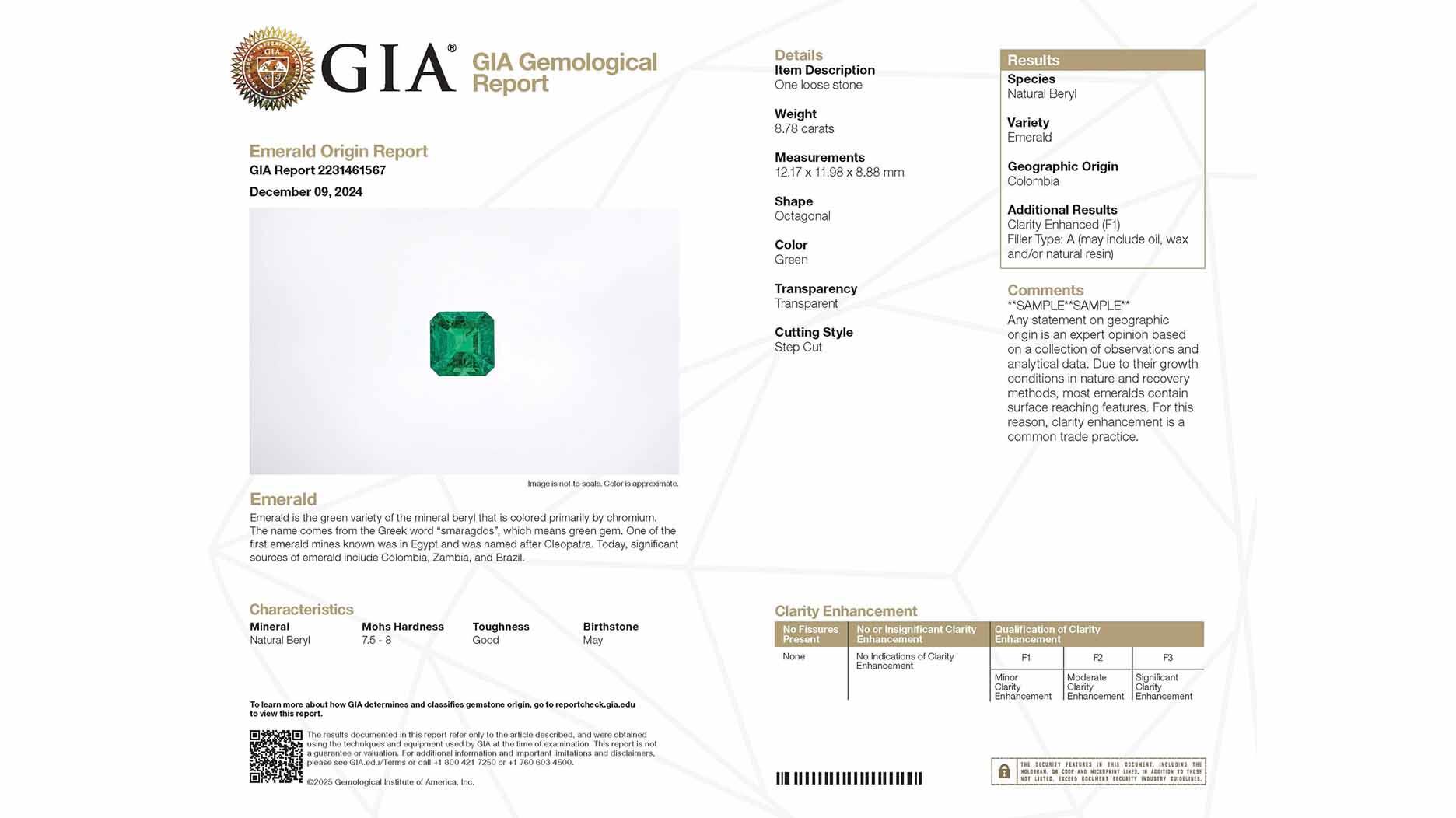Carlos Jose Hernandez and Joshua Zuazo were sentenced to life without the possibility of parole in the 2024 murder of Hussein “Sam” Murray.
JVC: Be careful about the grading reports you use
In a recent alert, the JVC reminded the industry that not only must the diamonds they sell be accurately graded but the grading system disclosed as well.

The bottom line is this: members of the industry who make claims about the grade or quality of a diamond that cannot be supported, or who don’t disclose the grading system, could be held liable. This includes telling consumers if the system being used color grades diamonds face up instead of face down (the industry norm), and how this might impact the grade.
In its alert, the JVC outlines four sections of the Federal Trade Commission’s Jewelry Guides that govern claims about diamond grades. Included in the outline are the following.
--FTC Guides require that if a representation is made about a grade, then the identity of the grading system must be disclosed. According to the guides, a representation that a stone is a specific grade is deceptive if the identity of the grading system used is not disclosed. This rule was created to ensure buyers know the basis upon which a grade was assigned and then can make informed comparisons.
--It is unfair and deceptive to misrepresent the grade of a diamond. The subjective element to grading means that there is tolerance in the industry for a diamond to be off by one letter grade; one lab, for example, might say that a diamond is an E color while another would evaluate the same stone and give it an F. The JVC said if a diamond grading case goes to court, the court likely would rely on these industry norms.
Labs that routinely produce reports that over-grade diamonds, “are likely engaging in a pattern and practice of deception,” the JVC said. This exposes them--and the sellers who use their reports--to potential government enforcement, class-action lawsuits brought by consumers (though they are not class actions, consumers already have brought grading report lawsuits in Tennessee) or Lanham Act (Trademark Act) lawsuits brought by competitors.
And, “It exposes the entire buying public to a crisis in confidence,” the JVC said.
Preventing deception
The JVC notes that there are circumstances surrounding diamond grades in which “clear and conspicuous” disclosure will prevent deception. “If a lab report uses a grading method that deviates in some respect from the industry norm, and if the method often results in different grades, this should be disclosed on the report so that the reasonable buyer is able to make an informed purchase.”
The example the JVC cites is the face-down (table-down) method of color grading. This is how the Gemological Institute of America grades its diamonds, and the JVC said it is accepted as the industry norm.
If a lab grades face up (table up), and this frequently results in different color grades than the industry norm, this must be “clearly, understandably and conspicuously disclosed,” the JVC said. “The disclosure should include a description of the practice used (e.g., face-up analysis) as well as the fact that the practice frequently results in different color grades than standard methods.”
The EGL labs outside the United States color grade their diamonds face up. In an interview following the announcement that the EGL International brand would be no more, EGL’s new global manager Menahem Sevdermish acknowledged as much. “Yes, it’s not GIA, it’s different,” he said.
Yet Sevdermish said the network of labs, which used the 0,1,2,3 system of color grading at one point, would continue color grading diamonds using the GIA’s D, E, F terminology, an action with which some disagree.
Martin Rapaport, who quit listing all diamonds with EGL grading reports on his diamond trading network in October in protest of over-grading, told National Jeweler Thursday that he won’t reverse his decision on not listing EGL-graded diamonds as long as EGL continues to color grade its diamonds face up.
He said any labs using GIA terminology need to use the GIA grading system; those not using the same system shouldn’t use the GIA’s terms for color and clarity, a point made in an earlier article by National Jeweler columnist and retailer Jim Alperin.
“It’s the confusion that’s so problematic here and confusion is the kissing cousin of misrepresentation,” Rapaport said.
Editor's note: This article was corrected to reflect the fact that there haven't been any class-action lawsuits regarding diamond grading reports filed in Tennessee. All the suits there have been filed by individuals.
The Latest

Yood will serve alongside Eduard Stefanescu, the sustainability manager for C.Hafner, a precious metals refiner in Germany.

The New Orleans jeweler is also hosting pop-up jewelry boutiques in New York City and Dallas.

How Jewelers of America’s 20 Under 40 are leading to ensure a brighter future for the jewelry industry.

Set in a Tiffany & Co. necklace, it sold for $4.2 million, the highest price and price per carat paid for a Paraíba tourmaline at auction.


The jeweler’s “Deep Freeze” display showcases its iconic jewelry designs frozen in a vintage icebox.

Take luxury gifting to new heights this holiday season with the jeweler’s showstopping 12-carat sphene ring.

Roseco’s 704-page catalog showcases new lab-grown diamonds, findings, tools & more—available in print or interactive digital editions.

This year's theme is “Unveiling the Depths of the Ocean.”

In its annual report, Pinterest noted an increase in searches for brooches, heirloom jewelry, and ‘80s luxury.

The 111-year-old retailer celebrated the opening of its new location in Salem, New Hampshire, which is its third store in the state.

The new catalog features its most popular chains as well as new styles.

The filmmaker’s personal F.P. Journe “FFC” prototype was the star of Phillips’ recent record-setting watch auction in New York.

The new location in the Design District pays homage to Miami’s Art Deco heritage and its connection to the ocean.

Inflations, tariffs, and politics—including the government shutdown—were among consumers’ top concerns last month.

“Longtime favorite” presenters, as well as first-time speakers, will lead talks and workshops at the annual event in Tucson next year.

Silas Smith of Meridian Metalworks won the challenge with his pendant that blends Australian and American landscapes.

The sale of the 31.68-carat, sunset-hued stone was part of Sotheby’s first series of events and auctions in Abu Dhabi.

Most customers who walk into your store this month have made up their minds. Your job is to validate their choice, Emmanuel Raheb writes.

The collection features characters and motifs from Ukrainian folklore, including an enchanted mirror and a magic egg.

MatrixGold 3.11, the newest version of the jewelry design program, offers more flexibility, precision, and creative control.

The pavilion will be part of the 2026 JA New York Spring show, scheduled for March 15 to 17.

Kadet, a 1994 National Jeweler Retailer Hall of Fame inductee, helped grow the family-owned retailer in the Chicago area and beyond.

Billed as the world’s smallest wearable, Lumia Health’s new smart earrings have a health tracker subtly embedded in the back.

Don’t let those with December birthdays feel blue. Help them celebrate their month with blue zircon, turquoise, and tanzanite.

The new pink sapphire version of the piece dances with its wearer in the brand’s “Icons After Dark” holiday campaign.

A choice that’s generated a lot of commentary, Pantone says “Cloud Dancer” marks a fresh start and encourages relaxation and creativity.



























